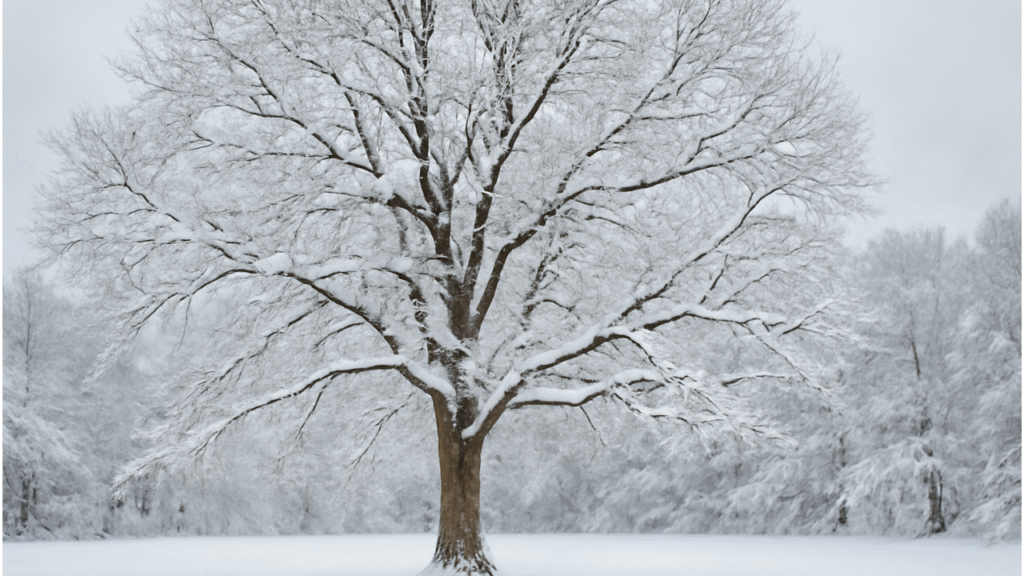
How to Care for a Hickory Tree in Winter: Essential Tips for Thriving Through the Cold Season
As the temperature drops and winter sets in, you might wonder how to protect your hickory tree from the harsh elements ❄️. While hickory trees are known for their resilience, the cold months bring unique challenges—freeze damage, snow accumulation, and wildlife threats can all take a toll on your tree. Without proper care, your hickory tree may struggle to thrive come spring.
But don’t worry, we’ve got you covered! In this article, we’ll walk you through essential tips on how to care for your hickory tree in winter, ensuring it stays healthy, strong, and ready to grow when the warmer months arrive 🌱. From watering strategies to trunk protection, these simple yet effective steps will give your hickory the best chance to weather the winter season without a hitch.

Keep reading to discover how you can safeguard your hickory tree in winter, and learn practical, easy-to-follow methods that any beginner can use!
Table of Contents
Toggle🪵🌨️ Understanding Hickory Trees: Winter Challenges 🌨️🪵
Hickory trees 🌳 are known for their toughness 💪, but the cold winter months ❄️ can still pose some serious challenges 🌬️. While they can survive through the season ⏳, they need extra care to ensure they thrive 🌱 when spring arrives 🌸. Let’s take a closer look 👀 at what makes hickory trees vulnerable in winter 🧊 and how to address these issues 🌿.
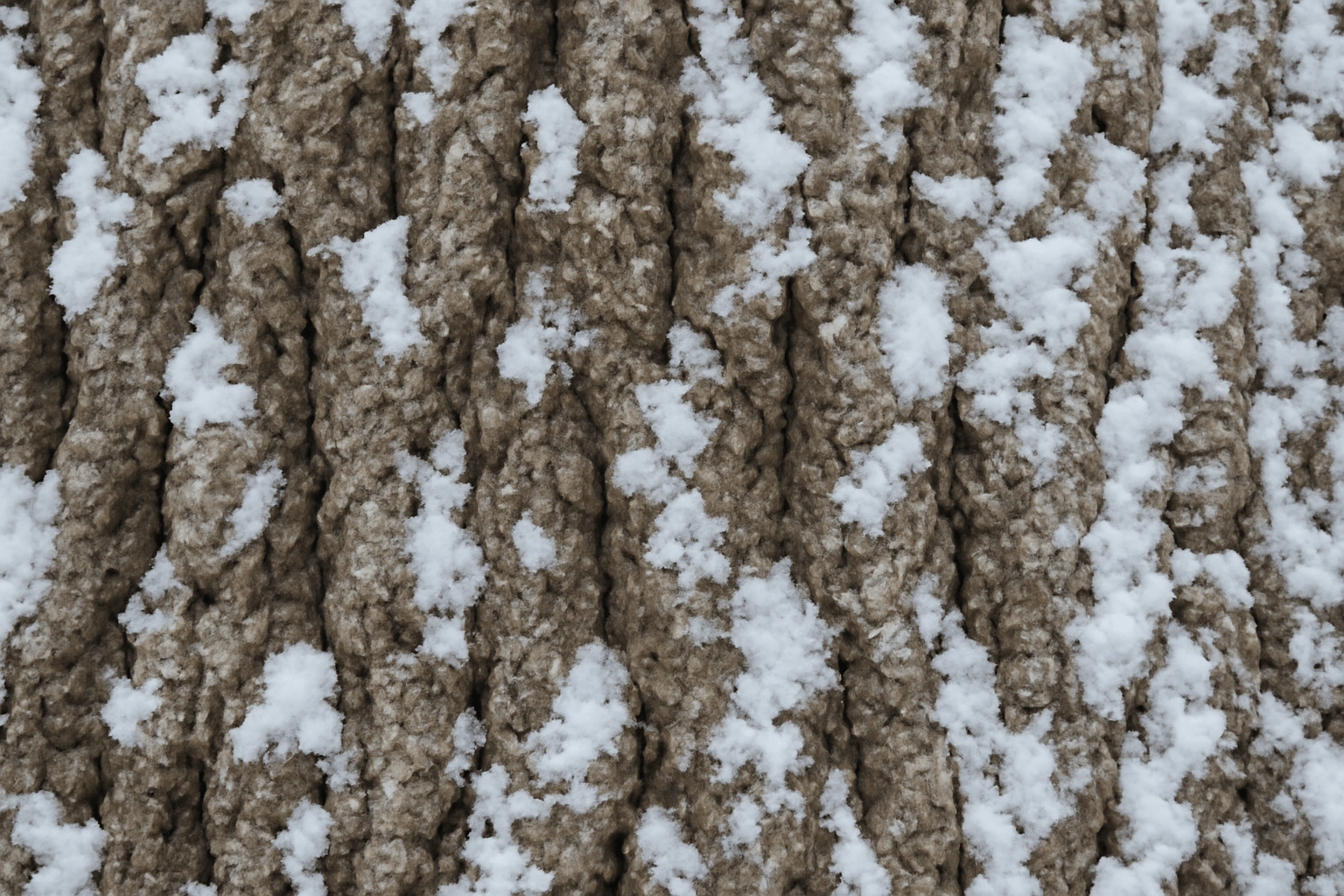
1. Cold Stress and Frost Damage ❄️
Hickory trees 🌳 can struggle with cold stress 😨, especially when temperatures drop too quickly 🌡️. The rapid freeze-thaw cycles 🌬️ that often occur during winter ❄️ can cause the tree’s cells to rupture ⚡, leading to frost damage 🌨️. This can result in bark splitting 🌳 or even dieback in some cases 😞. Understanding how to protect 🛡️ your tree from these extreme shifts in temperature 🌡️ is key to preventing this type of damage 🔧.
2. Snow and Ice Build-Up ❄️
Heavy snow ❄️ and ice 🧊 can accumulate on hickory tree branches 🌳, putting added weight 💪 on them. This can lead to broken or weakened branches 🌿, and in severe cases ⚠️, the entire tree 🌳 may be at risk of toppling ⬇️. While hickory trees 🌳 are strong 💪, the weight of snow ❄️ and ice 🧊 can strain them, particularly if they aren’t properly cared for during the winter months ❄️.
3. Dehydration in the Winter 💧
Even though hickory trees 🌳 are dormant in winter 💤, they still need moisture 💧. The cold temperatures ❄️ can cause the soil 🌍 to freeze, making it difficult for the tree to absorb water 💦. Without enough water 💧, hickory trees 🌳 may become dehydrated 😓, leaving them more vulnerable to diseases 🦠 and other stressors ⚠️. Proper watering 💦 before the ground freezes 🧊 is essential to keep your tree hydrated 💧 and healthy 🌱.
4. Wildlife Damage 🦌
Winter ❄️ is also the time when wildlife 🦝, like deer 🦌 and rodents 🐭, are more likely to cause damage to trees 🌳 in search of food 🍽️ or shelter 🏠. These animals 🦝 may chew on the tree’s bark 🌳, which can create entry points for pests 🐜 and diseases 🦠. Protecting your hickory tree 🌳 from wildlife threats 🦝 is an important step in ensuring its health 🌿.
By understanding these challenges ❄️, you’ll be better equipped 🛠️ to care for your hickory tree 🌳 through the winter 🧣. The next section will dive into the essential winter care tips 📝 to help you keep your hickory tree strong 💪 and safe 🛡️ through the cold months 🌬️. Stay tuned! 🌿
❄️🪵 Essential Winter Care Tips for Your Hickory Tree 🪵❄️
Winter care for hickory trees 🌳 is all about preparation 🛠️ and protection 🛡️. While these trees are resilient 💪, they need your help to survive the harsh conditions of the season ❄️. Here are some essential tips 💡 to ensure your hickory tree 🌳 stays healthy 🌱 and strong 💪 throughout winter 🧣.
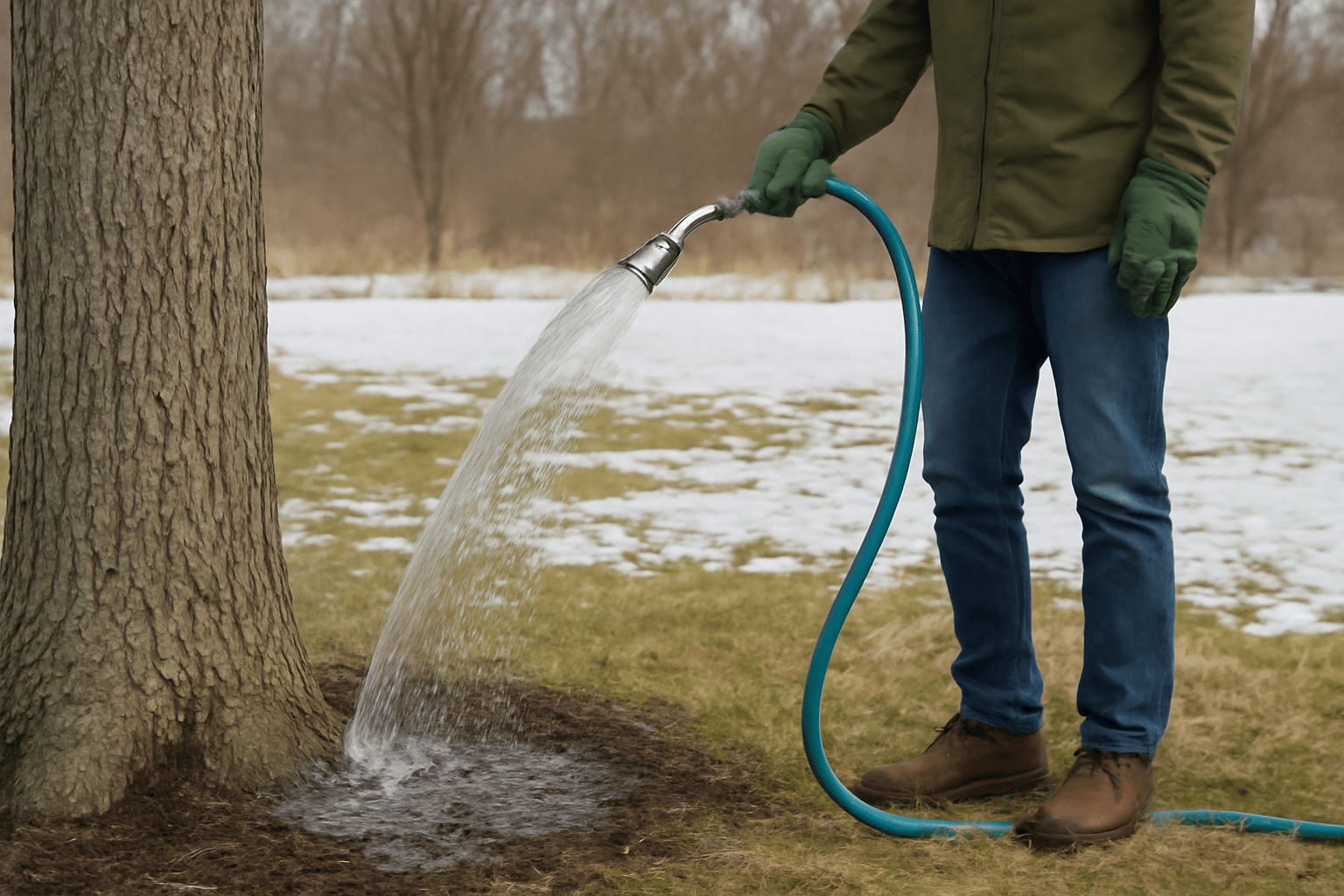
1. Deep Watering Before the Freeze 💧
Hickory trees 🌳 still need moisture 💧 in the winter ❄️, but with the soil often frozen 🧊, it can be hard for them to take up water 🌱. The key is to thoroughly water 🌊 your tree before the first freeze ❄️. Deep watering ensures that the roots stay hydrated 💦 during dormancy 💤. 🌿
Tip: Water on warmer days 🌞 when the ground is not frozen 🧊 to ensure the moisture reaches the roots 🌱.
How to Do It: Use a slow-drip hose 💧 or watering can 🌿 to ensure deep penetration into the soil 🌱.
2. Apply Mulch for Root Protection 🌾
Mulching 🌿 is one of the most effective ways to protect your hickory tree’s roots 🌳 during winter ❄️. A layer of mulch helps insulate the soil 🌍, keeping it warm 🔥 and moist 💧 while protecting the roots from freezing temperatures 🧊.
How to Apply: Spread 3-4 inches of organic mulch 🍂 (like wood chips 🪵 or shredded leaves 🍃) around the base of the tree 🌳, extending it several feet from the trunk 🌳.
Tip: Be careful not to pile mulch against the trunk 🌳, as it can trap moisture 💧 and cause rot 🦠.
3. Wrap the Trunk for Protection 🎀
Winter winds 🌬️ and sunscald 🌞 can be tough on hickory tree trunks 🌳, causing cracks and splits in the bark 🌳. Wrapping the trunk with burlap 🧣 or reflective tree wraps 🪶 can shield the tree 🌳 from temperature fluctuations 🌡️, reducing the risk of damage ⚠️.
How to Wrap: Use a soft, breathable material 🌿 like burlap 🧣 or a tree guard 🛡️, and wrap it around the trunk 🌳. Secure it loosely, allowing the tree to expand as it grows 🌳.
Tip: If you’re in an area with harsh winds 💨, use reflective tree wraps 🪶 to keep the temperature around the trunk steady 🌡️.
4. Remove Snow and Ice Buildup Carefully ☃️
Heavy snow ❄️ and ice 🧊 can strain your hickory tree’s branches 🌳, leading to breakage 💥. Gently remove snow 🌨️ buildup with a broom 🧹 or a soft-bristled brush 🖌️ to avoid damaging the bark 🌳. Don’t try to remove ice 🧊 unless it’s absolutely necessary 🛑, as the frozen branches 🌿 are fragile ⚠️.
Tip: Wait for ice 🧊 to thaw naturally 🌞 to avoid damaging the branches 🌳 by trying to break it off ❌.
How to Do It: Lightly shake the branches 🌿 to dislodge the snow ❄️, or use a broom 🧹 with soft bristles to brush it off gently 🪶.
5. Prune Wisely to Prevent Damage ✂️
While winter ❄️ isn’t the ideal time to prune ✂️, you can remove any dead or damaged branches 🌿 after the first frost 🌨️. This helps prevent breakage during storms ⛈️ or from heavy snow 🌨️ and ice 🧊. Don’t prune too much ✂️, as hickory trees 🌳 are dormant 💤 and heavy pruning can stress them out 🧠.
How to Prune: Use sharp, clean pruning tools ✂️ to remove dead or diseased limbs 🌿. Focus on branches 🌳 that may rub together or are weak 🌱.
Tip: Avoid cutting healthy branches 🌿 that could be essential for the tree’s health 🌱 come spring 🌸.
By following these simple yet effective winter care tips 💡, you’ll help ensure that your hickory tree 🌳 stays safe 🛡️ and strong 💪 throughout the cold season ❄️. Next, we’ll explore how to protect your tree 🌳 from wildlife 🦝 damage during the winter months 🌬️. Stay tuned! 🌳
❄️🌨️ Protecting Your Hickory Tree from Snow and Ice 🌨️❄️
Winter weather ❄️ can be especially harsh on hickory trees 🌳, with heavy snow ☃️ and ice 🧊 posing serious risks to the branches 🌿 and overall health of the tree 🌳. Proper protection 🛡️ is key to preventing breakage 💥, damage 🦠, and long-term stress 😓. Here’s how to safeguard your hickory tree 🌳 from the effects of snow ❄️ and ice 🧊 buildup.
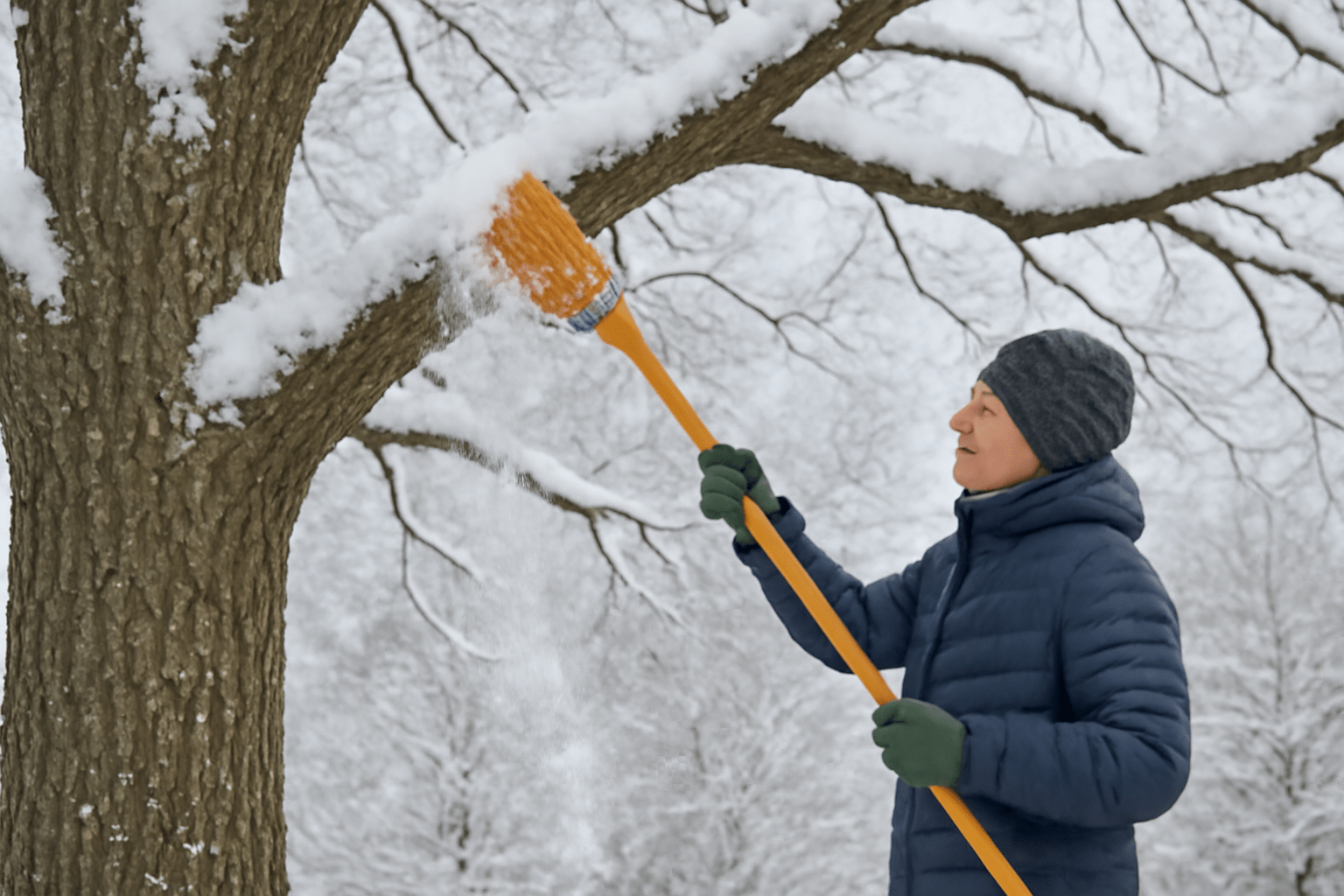
1. Remove Snow Gently ☃️
Accumulating snow 🌨️ on tree branches 🌳 can be heavy 🏋️♂️ and cause them to snap or bend 🌿. It’s important to remove snow promptly 🌨️, but do so with care 💕.
How to Remove Snow: Use a soft-bristled broom 🧹 or a long pole 🪶 to gently knock off snow ❄️ from the branches 🌳. Start from the bottom and work your way up ⬆️, shaking the snow off lightly to avoid damaging the tree 🌳.
Tip: Avoid using metal tools 🛠️ or forceful methods 💪 to remove snow, as they can scratch or break the branches 🌳.
2. Prevent Ice Accumulation 🌨️
Ice 🧊 can weigh down branches 🌳 and create dangerous conditions ⚠️ for your tree 🌳. When ice 🧊 builds up on the limbs 🌿, it can cause branches 🌳 to bend or break 💔. While it’s difficult to prevent ice 🧊 from forming, there are a few steps you can take to minimize the impact 💨.
How to Prevent Ice Damage: If ice 🧊 has already accumulated, wait for it to naturally thaw during warmer days 🌞. Trying to remove ice 🧊 by force ⚡ can cause fractures in the branches 🌳.
Tip: During extreme weather 🌬️, consider wrapping smaller branches 🌱 in burlap 🧣 or a tree guard 🛡️ to shield them from ice build-up 🧊.
3. Support Weak or Low-Hanging Branches 🪴
Some branches 🌿 may be more susceptible to damage 🦠 due to their position 📍 or weakness ⚠️. By supporting them 💪, you can help prevent breakage 💥 under the weight of snow ❄️ and ice 🧊.
How to Support Branches: Use tree props 🌳 or wooden stakes 🪵 to gently prop up weak 🌿 or low-hanging branches 🌱. Be careful not to tie them too tightly 🔒, as it can restrict their natural movement 🌱.
Tip: Always check the support system 🛠️ throughout the winter 🧣, ensuring it’s not too tight 🔴 or causing any additional stress to the tree 🌳.
4. Monitor for Breakage 🪓
Even with precautions 🛡️, snow ❄️ and ice 🧊 can cause branches 🌿 to snap under the weight 💥. Regularly inspect your hickory tree 🌳 to check for any damage 🦠.
How to Handle Broken Branches: If a branch 🌿 has broken or split 💔, it’s important to prune ✂️ it carefully to prevent further harm 🛠️. Use clean, sharp pruning tools ✂️ to remove damaged branches 🌿 without causing harm to the tree 🌳.
Tip: If a large branch 🌳 is broken or if you notice severe damage to the trunk 🌳, consider calling a professional arborist 🌳 for advice on how to safely handle the situation 🛠️.
By staying on top of snow ❄️ and ice 🧊 buildup and taking these steps 🔑, you can significantly reduce the risk of damage 🦠 to your hickory tree 🌳 during the winter months ❄️. Now that you’ve got the basics covered ✔️, let’s move on to protecting the trunk 🌳 and branches 🌿 from other winter challenges ❄️, like wildlife 🦝 and temperature fluctuations 🌡️. 🌲
✂️🌿 Winter Pruning: When and How to Do It 🌿✂️
Pruning your hickory tree 🌳 during winter ❄️ is a delicate task ⚖️. While the tree 🌳 is dormant 💤 and not actively growing 🌱, winter pruning can help maintain its health 🌿 and structure 🌳. However, improper pruning ✂️ can lead to unnecessary stress on the tree 🌳. Let’s explore the best practices for winter pruning to keep your hickory tree 🌳 strong 💪 and resilient 🌿 throughout the cold season 🌨️.
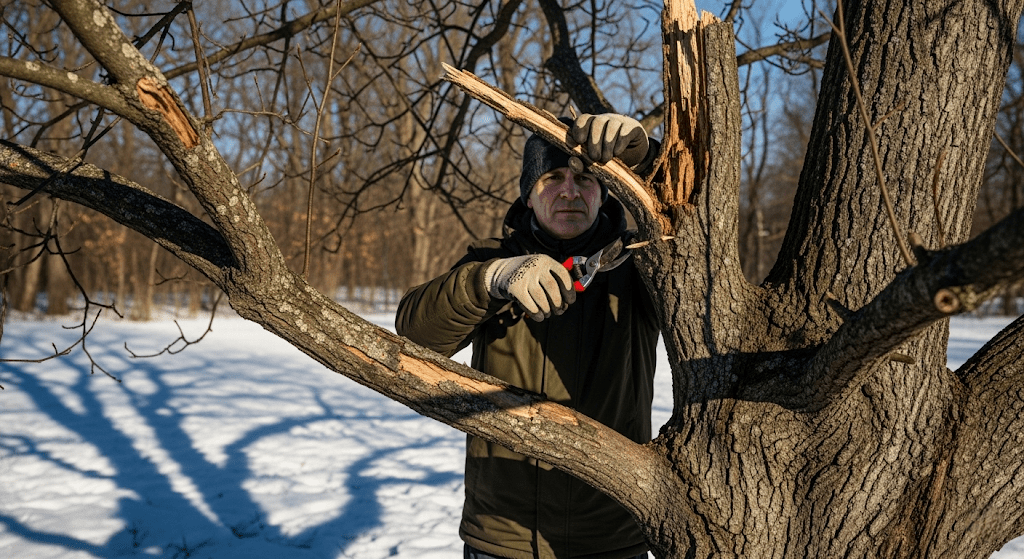
1. When to Prune Your Hickory Tree ❄️
Winter pruning is best done after the first hard frost 🌨️, but before the deep winter chill sets in 🌡️. This is when the tree 🌳 has entered dormancy 💤, which makes it less vulnerable to the shock of pruning ✂️.
Tip: Prune during the late winter or early spring 🌸—this gives the tree 🌳 time to heal 🩹 before the growing season begins 🌱.
Why Winter?: Pruning while the tree 🌳 is dormant 💤 reduces the risk of pest infestations 🐜 and disease transmission 🦠, as the tree 🌳 is not actively producing sap 💧.
2. What to Prune: Focus on Dead or Damaged Branches 🌿
The goal of winter pruning 🌿 is to remove dead, damaged, or diseased branches 🌳. These branches are not only unsightly 😖 but can also pose a risk to the overall health 🌿 of the tree 🌳. Removing them prevents the spread of disease 🦠 and improves the tree’s structure 🌳.
How to Prune: Look for branches 🌿 that are:
- Broken or cracked from winter storms ⛈️.
- Diseased, discolored 🌑, or brittle 🌿.
- Crossing or rubbing against other branches 🌿.
Tip: If you see a branch 🌿 that’s growing inward ↩️ or at an awkward angle ↪️, it’s best to remove it ✂️ to improve air circulation 🌬️ and sunlight exposure ☀️.
3. How to Prune Properly ✂️
Pruning your hickory tree 🌳 properly is crucial 💯 to avoid causing harm 🩹. Always use clean ✂️, sharp pruning tools 🔧 to make smooth cuts 🪓 that won’t damage the tree’s tissue 🌳.
Step-by-Step:
- Start by cutting any dead or diseased branches ✂️ first. Make cuts at a 45-degree angle ↗️ just above a healthy bud 🌿 or lateral branch 🌱.
- Trim back any branches 🌿 that are too close to the main trunk 🌳 or that are growing at an undesirable angle ↪️.
- Always make sure your cuts ✂️ are clean 🧼, and avoid leaving stubs that could lead to disease entry points 🦠.
Tip: Never remove more than 25% of the tree’s canopy 🌳 during a single pruning session 🗓️.
4. Avoid Over-Pruning 🌳
While it may seem tempting 😅 to prune heavily ✂️, especially after winter storms ⛈️, over-pruning can harm your hickory tree 🌳. Too much pruning ✂️ can stress the tree 🌳 and reduce its ability to store energy 🔋 for the growing season 🌱.
How to Avoid Over-Pruning:
- Stick to removing only the necessary branches 🌿—dead, diseased, or damaged 🌿.
- Avoid cutting healthy 🌱, living branches 🌳 that are essential to the tree’s structure 🌿.
Tip: If you’re unsure ❓ whether to prune a branch 🌿, it’s always safer to leave it 🌳 rather than remove it ❌.
5. Pruning Tools You’ll Need 🔧
Using the right tools 🛠️ is essential for a clean ✂️, effective cut 🔪. Here are the tools you’ll need for winter pruning 🌳:
- Bypass Pruners ✂️: Ideal for smaller branches 🌿 up to ¾ inch in diameter.
- Loppers 🔧: Great for slightly larger branches 🌿.
- Pruning Saw 🪚: Perfect for branches 🌳 larger than 1 inch in diameter.
Tip: Always disinfect your tools 🧴 before and after use to prevent the spread of disease 🦠.
Winter pruning ✂️ is a valuable part of hickory tree 🌳 care that, when done right 💯, can help improve the tree’s structure 🌳, health 🌿, and overall longevity 🕰️. By focusing on dead and damaged branches 🌿, using the proper tools 🛠️, and avoiding over-pruning ✂️, you’ll be setting your hickory tree 🌳 up for a strong 💪, healthy 🌱 spring 🌸. Next, we’ll explore the role of winter feeding 🌾 and whether or not your hickory tree 🌳 needs fertilizer during the cold months ❄️. 🌿
🌿❄️ Winter Feeding: Should You Fertilize in Winter? ❄️🌿
Winter ❄️ is a time when most trees 🌳, including your hickory tree 🌳, are in a state of dormancy 💤. During this time 🕰️, they aren’t actively growing 🌱, and their nutrient requirements are significantly reduced 🔽. So, does that mean winter ❄️ is the right time to fertilize 🌿 your hickory tree 🌳? Let’s break down 🧐 the role of feeding 🍽️ in the winter months 🧣 and when it’s beneficial for your tree 🌳.
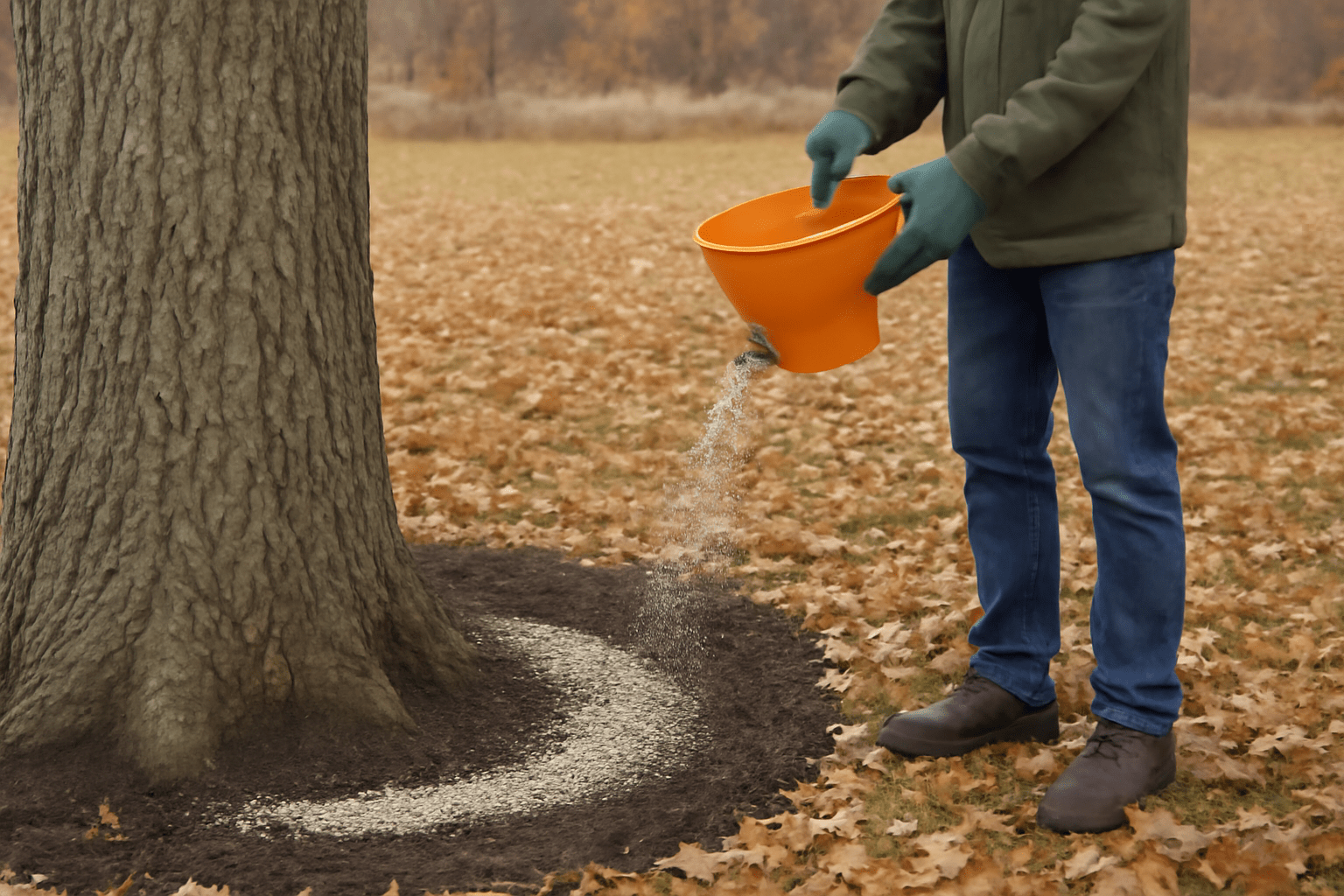
1. The Role of Fertilizing in Winter 🌱
Generally, trees 🌳 don’t need much fertilizer 🧪 during the winter ❄️ because they aren’t actively growing 🌱. However, there are exceptions 🧐. Fertilizing too early ⏰ or with the wrong kind of nutrients 🧪 can stimulate growth 🌱 before the tree 🌳 is ready, leading to weak, vulnerable new shoots 🌱 that may not survive the cold 🥶.
Tip: Avoid fertilizing 🧴 with high-nitrogen fertilizers 🌱 in winter ❄️, as they can encourage new, tender growth 🌱 that could be damaged by frost ❄️.
Why Fertilize in Winter?: Some experts 🧑🔬 suggest light fertilization 🌿 in late fall 🍂 or early winter ❄️ to help trees 🌳 store nutrients 🥦 for the upcoming growing season 🌱.
2. When Is the Right Time to Fertilize? ⏰
The best time ⏰ to fertilize 🌱 a hickory tree 🌳 is during the late fall 🍂 or early winter ❄️, before the ground freezes solid 🧊. This gives the tree 🌳 time ⏳ to absorb nutrients 🥦 and store them for spring growth 🌸.
Tip: Fertilizing 🧴 after the first frost 🌨️ but before the ground freezes 🧊 gives your tree 🌳 a nutrient boost ⚡ without causing it to push out new growth prematurely 🌱.
Why Wait Until Dormancy?: Fertilizing 🌱 during dormancy 💤 means the nutrients 🧪 won’t encourage excessive growth 🌿 but will prepare the tree 🌳 for a healthy start when the warm weather returns 🌞.
3. What Type of Fertilizer Should You Use? 🌾
Not all fertilizers 🧪 are created equal ⚖️, and using the right kind of fertilizer 💡 can make all the difference 🌱. During winter ❄️, your hickory tree 🌳 needs nutrients 🥦 that will help it endure the cold 🥶 and come out strong 💪 in spring 🌸.
- Slow-Release Fertilizers 🧴: These are ideal 🌟 for winter feeding 🍽️ because they provide a steady release 🕰️ of nutrients 🧪 over time ⏳. Slow-release fertilizers 🌿 are less likely to encourage rapid, vulnerable growth 🌱 during the cold months ❄️.
- Balanced Fertilizers ⚖️: A balanced fertilizer 🌱 with equal amounts of nitrogen (N) 🌿, phosphorus (P) 🌸, and potassium (K) 🌳 is ideal 🌱. This helps support root health 🌱 and the tree’s overall resilience 💪 without pushing out unnecessary growth 🌿.
Tip: Avoid high-nitrogen fertilizers 🌱, as too much nitrogen 🌿 can lead to excessive top growth 🌿 that is susceptible to cold damage ❄️.
4. How to Apply Fertilizer ❄️
When applying fertilizer 🧴, it’s important to follow the proper methods 🔧 to ensure the nutrients 🧪 are absorbed effectively 💡 and efficiently 🌿.
How to Apply:
- Spread the fertilizer 🧪 around the root zone 🌱, starting a few inches from the base of the tree 🌳 and extending out to the drip line 🌳 (where the tree’s branches end).
- Water the area thoroughly 💧 after applying the fertilizer 🧴 to help the nutrients soak into the soil 🌍.
Tip: Apply fertilizer 🧴 just before a good rain 🌧️ or water the area deeply 💧 afterward to ensure the nutrients penetrate the soil 🌍.
5. Signs Your Hickory Tree May Need Fertilization 🌳
Before applying any fertilizer 🧪, it’s important to evaluate 🧐 whether your hickory tree 🌳 actually needs it 🛠️. Here are some signs that might indicate a nutrient deficiency 🧪:
- Yellowing leaves 🍂 (if any remain) or poor growth 🌿 in the previous growing season 🌸.
- Thin or sparse foliage 🌿.
- Stunted growth 🌱 or poorly developed branches 🌳.
If you notice these symptoms ⚠️, light fertilization 🧴 may help support the tree’s health 🌱 going into the next growing season 🌸.
Winter feeding 🍽️ isn’t always necessary for your hickory tree 🌳, but if done correctly ✅, it can provide a helpful nutrient boost 💪. By using slow-release fertilizers 🧴 and applying them at the right time ⏰, you can help your tree 🌳 get ready for the growing season 🌸 without encouraging premature growth 🌱. Remember, less is often more ➖ when it comes to fertilization 🧴 in winter ❄️!
Next, we’ll explore how to protect your hickory tree 🌳 from wildlife damage 🦝, a common winter issue ❄️ that can harm your tree’s bark 🌳 and overall health 🌱. 🦌🌲
🦌🌳 Preventing Animal Damage to Your Hickory Tree in Winter 🌳🦌
During winter ❄️, hickory trees 🌳 face not only the elements 🌨️ but also the threat of animal damage 🦝. Wildlife 🦌, including deer 🦌, rodents 🐭, and rabbits 🐇, are more likely to seek shelter 🏡 and food 🍽️ from trees 🌳 in the cold months 🌨️, potentially causing significant harm 💥 to your hickory tree 🌳. Protecting your tree 🛡️ from these winter visitors 🦝 is an important part of ensuring its health 🌿 and longevity 🌱. Here are some practical 🛠️ and effective ways to prevent animal damage during the colder months ❄️.
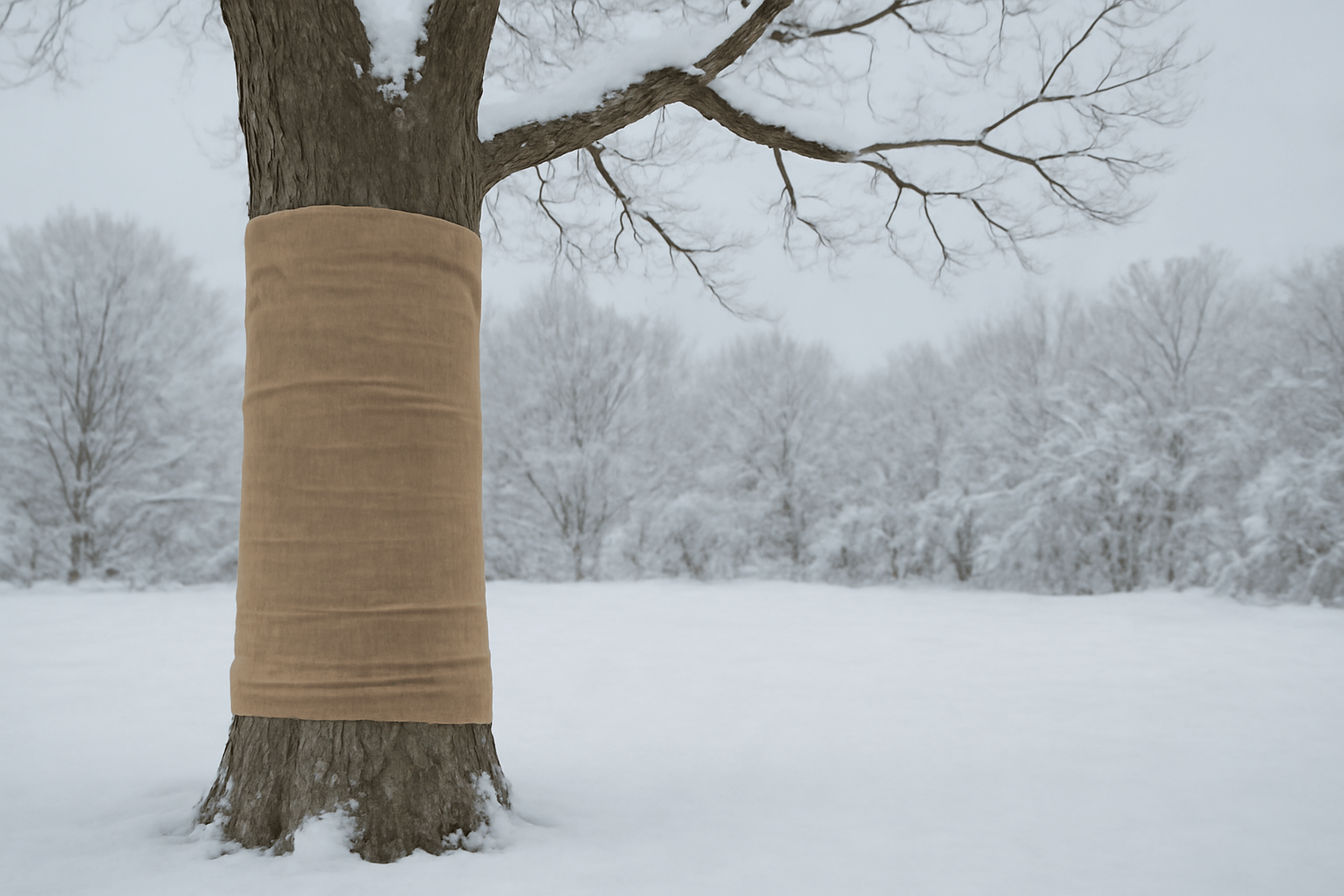
1. Wrap the Tree Trunk for Protection 🎀
One of the most common ways animals 🦝 damage trees 🌳 in winter ❄️ is by chewing on the bark 🌳. Deer 🦌, in particular, may strip bark 🌳 from lower branches 🌿 and the trunk 🌳, causing permanent damage 💔. To protect your hickory tree 🌳, wrapping the trunk 🎀 can provide a physical barrier 🛡️ between the tree 🌳 and wildlife 🦝.
How to Wrap: Use tree guards 🌳 or burlap 🧣 to wrap the trunk 🌳. Start at the base 🌱 and go up to the first major branches 🌿. Ensure the wrap is loose enough 🔴 to allow the tree 🌳 to expand but secure enough to stay in place during the winter ❄️.
Tip: Reflective tree wraps 🌟 can be especially effective at deterring animals 🦝, as the shine ✨ and movement 🌬️ can scare them away 👻.
2. Install a Wire Mesh Fence Around the Base 🛡️
If you’re dealing with a significant wildlife problem 🦝, a wire mesh fence 🦠 can act as an effective deterrent 🚫. This will prevent deer 🦌 and small animals 🐿️ from getting too close to the trunk 🌳 and branches 🌿.
How to Install: Place the fence 🛡️ about 18–24 inches away from the base of the tree 🌳. The fence should be at least 3–4 feet tall 🧍♂️ to keep deer 🦌 from reaching the branches 🌿. Bury the bottom of the fence a few inches into the ground 🌍 to prevent rodents 🐭 from sneaking underneath 🔑.
Tip: Use a fine mesh 🐇 or chicken wire 🦠 for smaller animals 🐿️ like rabbits 🐇 and squirrels 🐿️. Make sure the fence is tall enough ⬆️ to prevent deer 🦌 from jumping over.
3. Use Animal Repellents 🦨
Animal repellents 🧴 can be an effective way to keep unwanted visitors 🦝 away from your hickory tree 🌳. These sprays typically have strong scents 🌿 or tastes 😖 that animals 🦝 find unpleasant, which can discourage them from approaching the tree 🌳.
How to Use Repellents: Apply repellent 🧴 around the base 🌳 of the tree 🌳, focusing on areas where animals 🦝 are likely to chew 🍽️, such as the trunk 🌳 and lower branches 🌿. Reapply the repellent regularly ⏰, especially after snow 🌨️ or rain 🌧️, to maintain its effectiveness ⚡.
Tip: Some natural repellents 🌿 include garlic 🧄, hot pepper 🌶️, or even predator urine 🦉, which can be found at garden centers 🏡.
4. Create a Barrier with Burlap Screens or Mesh Netting 🌿
To protect the lower branches 🌿 from browsing animals 🦝 like rabbits 🐇 and deer 🦌, you can create a barrier 🛡️ around your tree 🌳 using burlap 🧣 or mesh netting 🪶. This will help prevent the animals 🦝 from nibbling on the tree’s foliage 🌿, buds 🍂, or bark 🌳.
How to Use: Surround the tree 🌳’s lower branches 🌿 with burlap 🧣 or netting 🪶, ensuring it’s secure 🔒 but not too tight 🌱. This will block access 🚫 to vulnerable parts of the tree 🌳.
Tip: Make sure the netting 🪶 or burlap 🧣 is high enough ⬆️ to prevent deer 🦌 from reaching over it 🌿 and eating the tree 🌳.
5. Encourage Natural Predators 🦉
Some animals 🦝, like deer 🦌 and rabbits 🐇, may be less likely to venture near your tree 🌳 if they sense the presence of natural predators 🦉. While you can’t always control this 🌍, you can encourage the presence of animals 🦉 like owls 🦉 or hawks 🦅, which can help keep smaller animals 🦝 at bay.
How to Encourage Predators: Install owl boxes 🦉 or other bird habitats 🦜 nearby to attract natural predators 🦅 to your yard 🌳.
Tip: You can also use reflective objects ✨ like scare-eye balloons 🎈 or aluminum foil strips 🎋 to create movement 🌬️ and make animals 🦝 feel unsafe ⚠️.
6. Check for Damage Regularly 🔍
Even with protective measures 🛡️ in place, it’s important to inspect your hickory tree 🌳 regularly for signs of animal damage 🦝. If you catch the problem early 🧐, you can address it before it becomes too serious 🔴.
What to Look For:
- Scratches 🧑🔬 or chew marks on the bark 🌳.
- Evidence of rodent burrowing 🐭 around the base of the tree 🌳.
- Any signs of stripped branches 🌿 or missing buds 🍂.
Tip: If you notice significant damage 💥, consider calling a tree care professional 🌳 for advice on how to proceed 🛠️.
By taking these simple but effective steps 🛠️, you can protect 🛡️ your hickory tree 🌳 from animal damage 🦝 throughout the winter months ❄️. A little extra effort 💪 now will help ensure your tree 🌳 remains strong 💪 and healthy 🌿, ready to thrive 🌱 in the warmer months 🌞. Next, we’ll cover how to identify and manage winter tree stress ❄️, including the common signs to watch out for 👀. 🌳
🌲❄️ Identifying and Managing Winter Tree Stress ❄️🌲
Winter ❄️ can be a tough time for trees 🌳, including your hickory tree 🌳. The cold weather 🌨️, combined with snow ❄️, ice 🧊, and drying winds 🌬️, can put your tree 🌳 under significant stress 😓. Recognizing the signs of stress early 🔍 can help you take action ⚠️ before it becomes a bigger problem 🛠️. Let’s dive into how to identify 👀 and manage winter stress ❄️ in your hickory tree 🌳, so it stays healthy 🌱 throughout the season 🌿.
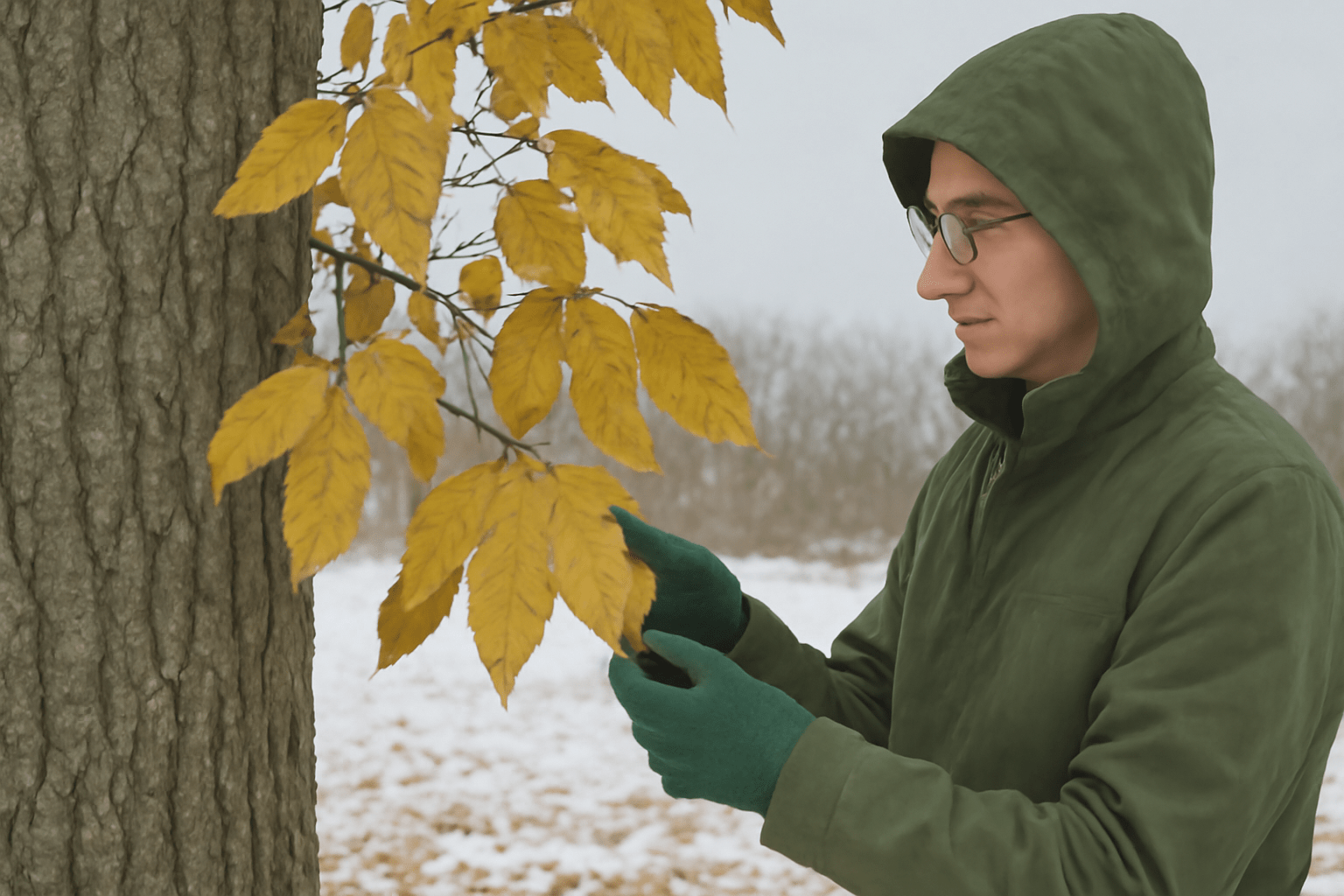
1. Common Signs of Winter Stress in Hickory Trees 🔍
Knowing the signs of winter stress ❄️ will help you monitor 👀 your tree 🌳 and provide the necessary care 🛠️. Here are some symptoms to look out for:
🌳 Bark Cracking or Peeling 🌳
When temperatures fluctuate rapidly 🌡️, the outer layers of the bark 🌳 may expand and contract, causing cracks or splits 🌿. This is often seen in trees 🌳 exposed to strong winter sunlight 🌞, a condition called sunscald 🌞.
🍂 Yellowing or Browning Leaves 🍂
Although hickory trees 🌳 shed their leaves 🍃 in winter ❄️, if any leaves remain 🍂, they may turn yellow 💛 or brown 🤎. This can be a sign of dehydration 💧 or insufficient nutrients 🧪.
🌿 Broken or Weakened Branches 🌿
Snow ❄️, ice 🧊, and wind 🌬️ can cause branches 🌳 to snap 🌿. If you notice broken or hanging branches 🌳, this could indicate stress caused by heavy snow accumulation ❄️ or wind damage 🌬️.
🌱 Reduced Growth in Spring 🌱
If your hickory tree 🌳 shows little to no growth 🌱 when spring 🌸 arrives, it could be a sign that it didn’t properly survive the winter stress ❄️.
2. What Causes Winter Stress in Hickory Trees? 🌬️
Winter stress ❄️ can be caused by several factors 🌍, and understanding them helps in preventing future damage 🛠️. Here are the most common causes ⚠️:
🌡️ Temperature Fluctuations 🌡️
Rapid temperature changes 🌞❄️ can lead to freezing and thawing cycles 🔄 that weaken tree tissues 🌳. This is especially problematic if the tree 🌳 is dehydrated 💧 or stressed before the cold 🥶 hits.
❄️ Snow and Ice Accumulation ❄️
Heavy snow ❄️ and ice 🧊 put excessive weight 🏋️♂️ on branches 🌿, leading to breakage 💥 or bending 🌳. Over time ⏳, this can affect the tree’s structure 🌳 and overall health 🌱.
🌬️ Dry Winter Winds 🌬️
Cold, dry winds 🌬️ can cause the tree 🌳 to lose moisture 💧, leading to dehydration 💧. Even though the tree 🌳 is dormant 💤, it still needs adequate hydration 💦 to stay healthy 🌱.
🦝 Wildlife Damage 🦝
Animals 🦝 such as deer 🦌, rodents 🐿️, and rabbits 🐇 can cause winter stress ❄️ by chewing on the bark 🌳, branches 🌿, or buds 🌱, creating entry points for disease 🦠 and pests 🐜.
3. How to Manage and Prevent Winter Stress 🌱
There are several ways to manage 🛠️ and prevent winter stress ❄️, ensuring your hickory tree 🌳 remains in good condition throughout the cold months 🌨️:
💧 Provide Adequate Watering 💧
Ensure your hickory tree 🌳 is well-hydrated 💦 before the ground freezes 🧊. Deep watering 💧 helps the tree 🌳 store moisture 🥶, which can be crucial for its survival during the dry winter months 🌬️. Water the tree 🌳 during any warm spells 🌞 when the ground isn’t frozen 🧊.
🌞 Protect the Trunk from Sunscald 🌞
Wrapping the trunk 🌳 with burlap 🧣 or reflective tree wraps 🌟 can help protect the tree 🌳 from the sun’s warming rays 🌞, which can cause the bark 🌳 to crack. This protection also shields the tree 🌳 from drying winds 🌬️.
❄️ Remove Excess Snow and Ice Gently ❄️
Use a soft broom 🧹 to remove snow ❄️ from branches 🌳, and avoid trying to break off ice 🧊. If ice 🧊 builds up on the tree 🌳, wait for it to thaw naturally 🌞, as sudden force ⚡ can break branches 🌿.
🌬️ Install a Windbreak 🌬️
Planting a windbreak 🌳 or using a temporary fence 🛡️ around your tree 🌳 can help reduce the impact 🌬️ of cold, drying winds 🌬️. This will protect your hickory tree 🌳’s foliage 🍃 and reduce moisture loss 💧.
✂️ Prune Wisely ✂️
Prune any dead 🌿 or damaged branches 🌳 before winter ❄️ to reduce stress on the tree 🌳. Avoid pruning live branches 🌿 during the winter ❄️, as it can make the tree 🌳 more susceptible to damage from freezing temperatures 🧊.
🦝 Protect from Wildlife 🦝
Use tree guards 🌳 or wrap the trunk 🌳 with burlap 🧣 to prevent animals 🦝 from chewing on the bark 🌳. Install a wire mesh fence 🦠 around the base 🌱 to keep rodents 🐿️ and deer 🦌 from getting too close.
4. What to Do If Your Tree Is Severely Stressed ⚠️
If you notice severe winter stress ❄️ signs, such as significant bark damage 🌳, broken branches 🌿, or poor growth 🌱 in spring 🌸, it may be time 🕰️ to consult a professional arborist 🌳. A tree care professional 🌿 can help assess the tree’s health 🌱, provide advice on recovery 🩹, and even recommend treatments 💉 to boost the tree’s resilience 💪.
Tip: If you suspect disease 🦠 or pest infestations 🐜 due to winter damage 🧊, a professional can inspect the tree 🌳 and recommend appropriate treatment options 💉.
By identifying 👀 and addressing winter stress 🧊 early on, you can ensure your hickory tree 🌳 survives the cold months ❄️ and emerges healthy 🌱 and strong 💪 in the spring 🌸. Proper care 💧—such as watering 💦, protecting from the wind 🌬️, and removing snow ❄️—will help prevent damage 💥 and promote long-term tree health 🌳. Now that you’ve learned about stress management 🌱, let’s look at some frequently asked questions ❓ to clear up any lingering doubts 🧐! 🌳
🌿❄️ Final Thoughts ❄️🌿
Caring for your hickory tree 🌳 during the winter months ❄️ may seem like a challenge 💪, but with the right approach 🔧, you can ensure your tree 🌳 remains healthy 🌱 and strong 💪, ready to thrive 🌸 come spring 🌱. By following the essential tips 💡—like deep watering 💧 before the freeze 🧊, applying mulch 🍂, wrapping the trunk 🎀 for protection, and monitoring 👀 for signs of stress 😓—you’ll be setting your hickory tree 🌳 up for success 🏆.
Winter ❄️ doesn’t have to be a harsh season 🧊 for your tree 🌳. By understanding the challenges ⚠️ it faces and taking proactive steps 🛠️ to address them, you’re giving your hickory 🌳 the best chance to weather the cold 🥶 and emerge even stronger 💪.
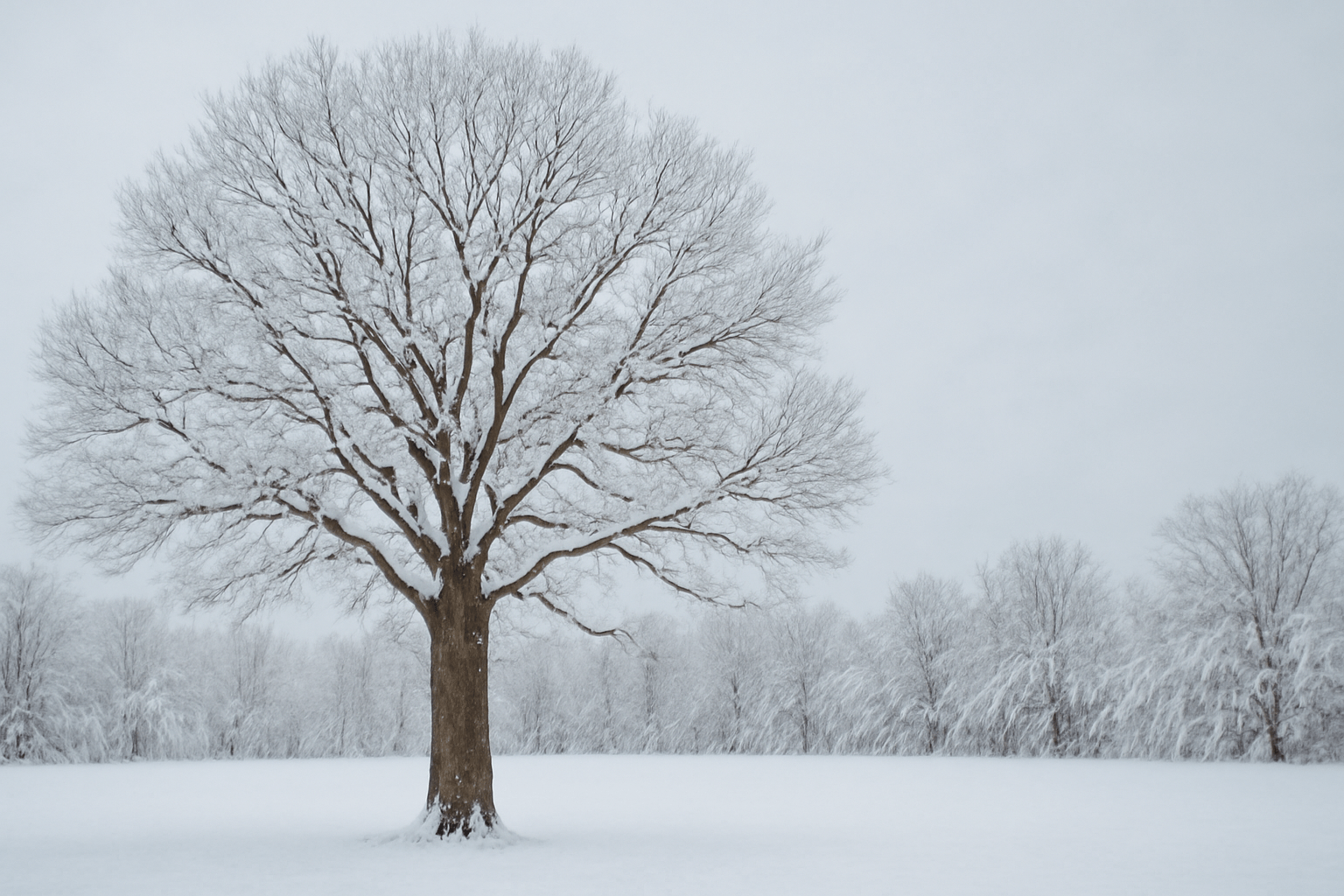
Remember, a little effort now ⏰ can go a long way 🌍 in maintaining the beauty 🌸 and health 🌱 of your hickory tree 🌳 for years to come 🕰️. So take the time 🕰️ to care for it this winter ❄️, and enjoy watching it grow 🌱 and flourish 🌿 in the seasons ahead 🌸! 🌱✨
Frequently Asked Questions (FAQs)
Should I water my hickory tree in winter? 💧
Yes, hickory trees still need water in winter, but you must water them before the ground freezes. Deep watering helps ensure the roots stay hydrated, especially during dry spells. Water the tree on warmer days when the soil isn’t frozen, ensuring moisture reaches the roots.
How do I protect my hickory tree from snow and ice? ❄️
To protect your hickory tree, gently remove snow from its branches using a soft broom. Don’t try to remove ice forcibly, as it can damage the branches. If ice accumulates, let it thaw naturally to avoid breaking branches.
When is the best time to prune my hickory tree in winter? ✂️
Prune your hickory tree after the first hard frost but before the deep winter chill sets in. Winter pruning helps remove dead or damaged branches without stressing the tree, allowing it to heal before the growing season starts.
Do I need to fertilize my hickory tree in winter? 🌱
It’s generally not necessary to fertilize in winter, but light fertilization with slow-release nutrients in late fall or early winter can give the tree a nutrient boost. Avoid high-nitrogen fertilizers, as they may encourage unwanted growth during the cold months.
How can I prevent animals from damaging my hickory tree in winter? 🦌
To prevent wildlife damage, wrap the tree trunk with burlap or tree guards to deter animals from chewing on the bark. You can also install a wire mesh fence around the base of the tree to keep rodents and deer away.
What are the signs of winter stress in a hickory tree? 🔍
Signs of winter stress include cracked or peeling bark, yellowing or browning of remaining leaves, broken branches, and poor growth in spring. If you notice these, it may indicate that your tree is struggling with cold weather or moisture loss.
How can I protect my hickory tree’s roots during winter? 🌾
Apply a thick layer of mulch around the base of the tree to insulate the roots and keep them warm. This will help prevent the soil from freezing too quickly and keep moisture levels stable throughout the winter.
Can I over-prune my hickory tree in winter? ❌
Yes, over-pruning can harm your hickory tree by stressing it during its dormant period. Focus on removing only dead, damaged, or diseased branches, and avoid cutting back healthy growth. Never remove more than 25% of the tree’s canopy in one pruning session.
